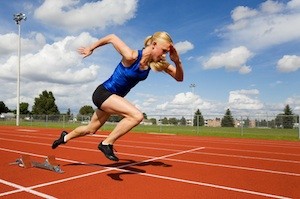Earthing And Recovery From Post Exercise Muscle Soreness

If you’ve suffered from sore muscles in the days after intense or unusual exercise, you might want to practice Earthing to give your muscles a recovery boost.
You may have heard about athletes using Earthing to help them recover quicker after putting there bodies under intense physical stress. You may have wondered if grounding really helped those athletes recover quicker or if they were only experiencing a placebo effect.
In this article the truth about whether or not Earthing can help YOU recover FASTER from DOMS (delayed onset muscle soreness) is revealed. The results are from the Pilot Study On The Effect Of Grounding On Delayed-Onset Muscle Soreness in 2010, which has been recorded in the Journal Of Alternative And Complimentary Medicine.
 The study tested Grounding on 8 men between the ages of 20 and 23, who were examined to make sure they were healthy and free of disease or injury. Extra controls were used to make sure the results of this study were as accurate as possible.
The study tested Grounding on 8 men between the ages of 20 and 23, who were examined to make sure they were healthy and free of disease or injury. Extra controls were used to make sure the results of this study were as accurate as possible.
4 of the participants were grounded and 4 were sham grounded. With SHAM grounding real Earthing devices were used to give participants the impression they were being grounded but the devices weren’t connected to the ground. This measure was taken to make sure the study was double blind, so that the investigator and the participants DIDN’T know who was grounded and who wasn’t.
In addition each of the men consumed exactly the same meals in the same proportions at the same times of day. They were required to sleep and be connected to the GROUNDING or SHAM grounding devices during the same hours as well.
To create the effect of DOMS, all of the participants were given a bar bell weighing a third of their body weight and did an exercise called toe raisers. The exercise required them to put there toes on a 2 x 4, so there toes were about 2 inches higher than their heels, then raise there heels up till they were standing all the way up on their toes. They had to hold that position for 10 seconds then lower their feet back to the floor and repeat it a total of 20 times. After resting for 2 minutes they had to repeat the exercise one more time.
A wide variety of data was collected from each of the participants over a 4 day period to determine differences between the grounded and ungrounded participants, which included blood sampling, magnetic resonance imaging, saliva cortisol sampling, and pain tests.
2 types of subjective pain tests were used to see if there were any differences in pain between the grounded and ungrounded participants.
A visual analog pain scale was used to rate the perception of pain each participant felt at hours 24, 48, and 72 AFTER the exercise, and a blood pressure cuff was used to see how much pressure each of them could take before asking the investigator to stop because of the pain. The grounded group had a significantly lower perception of pain and could also tolerate more pressure than the ungrounded group.
Researchers reviewed data from 144 points they obtained in the study. One of the most SIGNIFICANT differences they found between the grounded and ungrounded subjects was revealed by the levels of certain types of white blood cells present in the blood of each person at specific hours after intensive exercise.
As quoted from the study “An increase in white blood cell production occurs when the immune system is called upon to defend the body against infectious disease, foreign materials, or damaged cells.” The cool thing revealed in this study was the GROUNDED subjects had a slight decrease in white blood cells at hours 24, 48 and 72 which indicated almost no inflammation.
The UNGROUNDED participants experienced an increase in white blood cell production recorded at the same hours as the grounded subjects experienced the decrease, which is typical of an acute inflammation response.
Based on the results the data revealed, it was determined that Earthing after intense exercise APPEARS to have the potential to both IMPROVE muscle function related to post exercise muscle soreness and SHORTEN the time needed for recovery. This is the first of any study to reveal a shortened recovery time for delayed onset muscle soreness; and GROUNDING people was all it took to produce the results.
The researchers have said the results grounding produced were great enough to warrant a larger scale study with more participants.
Recovering quicker from exercise isn’t the only reason to get grounded more often but it sure is a good one. If you have any personal experience regarding quicker recovery from exercise as a result of Earthing yourself, feel free to share it in the comments section below.
==>Click Here To Browse Official Earthing Products<==
Let us know if this delayed onset muscle soreness remedy works for you.
